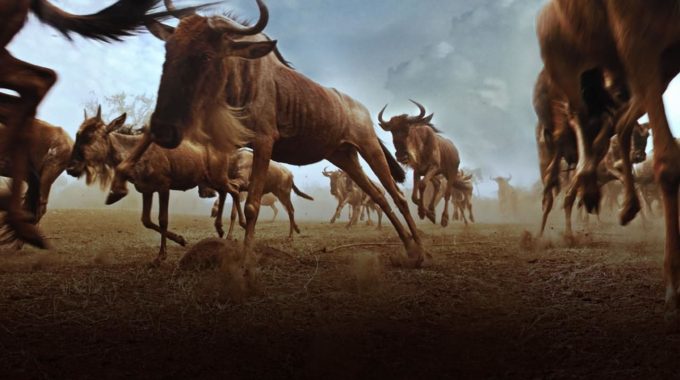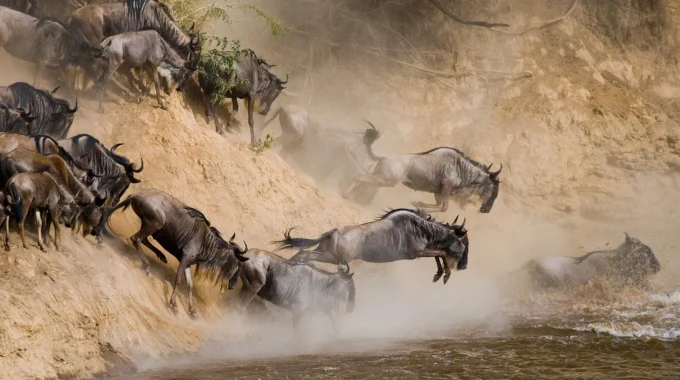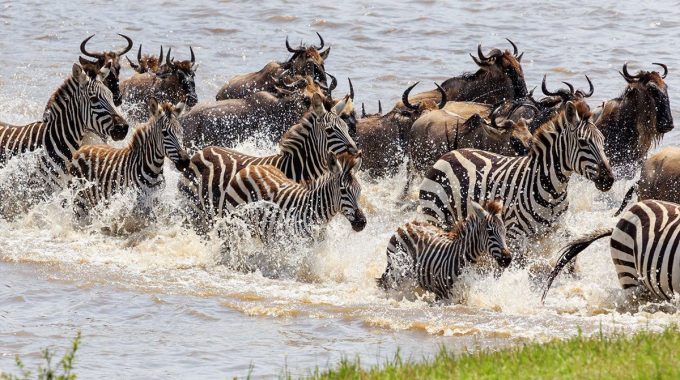How fast do wildebeest reproduce? - Wildebeests (Connochaetes spp.) are iconic members of the African savannas…
What is the world’s largest animal migration?
What is the world’s largest animal migration?
The Great Migration in Kenya and Tanzania is the world’s largest animal migration and one of the most spectacular wildlife phenomena on the planet. This migration involves the movement of millions of wildebeest, zebras, and gazelles across the Serengeti-Mara ecosystem, which spans northern Tanzania and southern Kenya. Here’s a detailed look at this incredible migration:

1. The animals involved:
-
Wildebeest: The main species involved in the migration, with about 1.5 million wildebeest making the journey each year.
-
Zebras: Around 250,000 zebras also migrate alongside the wildebeest, following the same path for grazing and water.
-
Gazelles: Gourmet gazelles and other antelopes also participate, although in smaller numbers, contributing to the complexity and dynamics of the migration.
2. The Migration Route:
-
Start in the Serengeti (Tanzania): The migration begins in the southern Serengeti, where the wildebeest give birth to their young between January and March. This is a time of plenty, with grasslands full of nutritious grasses and fresh rainwater.
-
Moving North: As the dry season approaches in the Serengeti’s southern region, the animals start their journey northwards toward the Masai Mara in Kenya. This migration occurs in search of food and water, driven by the seasonal rains.
-
Crossing the Mara River: The most dramatic part of the migration takes place as the animals cross the Mara River into Kenya. This is the most perilous segment, as they face dangers from crocodiles, hippos, and predators like lions, leopards, and cheetahs that lie in wait.
-
Return South: After grazing in the rich pastures of the Masai Mara during the dry season (typically from July to October), the herds begin to move back south to the Serengeti in November and December, completing the circular migration cycle.
3. The timing of the migration:
- Rainfall patterns influence the availability of water and fresh grass, which primarily drives the migration. Generally speaking, the migration cycle operates as follows, though the precise dates may vary from year to year depending on the weather:
- January to March: Calving season in the southern Serengeti, a time of high fertility.
- April to May: The herds move northward as the dry season begins to set in.
- June to July: The herds are in the Masai Mara, preparing to cross the Mara River.
- August to October: Peak of the migration in the Masai Mara, with dangerous crossings.
- November to December: The herds start returning to the Serengeti, where the cycle begins again.
4. Challenges of the Migration:
- Predators: Lions, hyenas, leopards, and cheetahs all follow the migration, hunting the weak, young, and injured. The wildebeest are particularly vulnerable during the river crossings.
- River Crossings: The Mara River is infamous for its crocodile-infested waters and swift currents. This is a critical point in the migration, with many wildebeest and zebras falling prey to crocodiles as they attempt to cross. In contrast, herds can cross the river as a group, overcoming threats through sheer numbers.
- Weather and Food Availability: If there’s a delay in rainfall or drought conditions, the animals face a scarcity of water and food, which can significantly impact their health and survival. The availability of grazing land is a driving force for their movement.
5. Ecological and Economic Impact:
-
Predator-Prey Dynamics: The migration serves as a consistent source of food for lions, cheetahs, and other predators in the Masai Mara and Serengeti. If a lot of herbivores migrate at once, there might be intense competition and predation.
-
Tourism: The Great Migration is a major tourist attraction, drawing millions of visitors each year to witness this spectacle. The mutual benefits of safari operations and park admission fees have linked migration and tourism in Kenya and Tanzania.
-
Biodiversity: The migration supports biodiversity in the ecosystem by ensuring that nutrients are redistributed across large areas. The grazers keep the grasslands healthy and in balance, allowing for the growth of new plants that other animals depend on.
6. Conservation Challenges:
-
Human-Wildlife Conflict: As human populations increase around the Serengeti and Masai Mara regions, the migration path is increasingly threatened by agricultural development, infrastructure, and encroachment into wildlife areas. Conservation efforts are critical to protecting migration corridors.
-
Climate Change: Climate change is altering rainfall patterns, which can impact the timing and success of the migration. Food and water scarcity brought on by droughts and erratic weather patterns can impact migratory animals, including their predators.
7. The Spectacle:
- The Great Migration is commonly referred to as the “Greatest Show on Earth” due to its breathtaking spectacle. Predator-prey drama is as dramatic as the herds of wildebeest crossing rivers. There is constant struggle for survival, with lions pursuing the herds, crocodiles waiting in the water, and cheetahs pursuing fast.
Conclusion:
The Great Migration is an extraordinary natural event that highlights the beauty and brutality of nature. One of the most significant and spectacular migrations on Earth takes place in East Africa. Here millions of animals traverse vast distances, overcome enormous challenges, and contribute to the ecological balance of the Serengeti-Mara ecosystem. Its wildlife, scenery, and animal survival drama make it a must-see for tourists and nature lovers.
Contact Adventure in the Wild Safaris for inquiries and quotes about the Great Wildebeest migration safaris.



